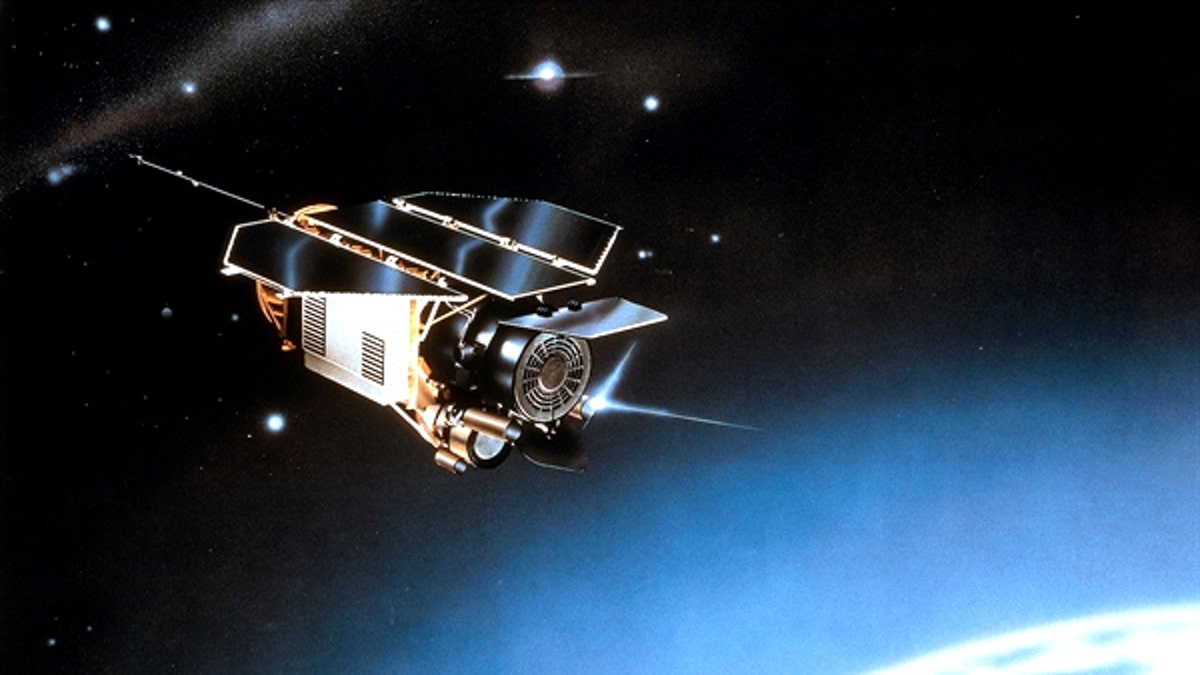
An artist's impression of the German ROSAT satellite orbiting in space. (German Aerospace Center)
Sometime this weekend, the sky will actually be falling.
A defunct German Roentgen satellite, or ROSAT, the size of a large car is set to plunge to Earth somewhere between Saturday and Sunday -- and experts say there's no way to precisely determine where it will crash.
But thanks to a neat widget built just for FoxNews.com by the satellite-tracking website N2YO.com, you can watch the falling satellite as it courses through the heavens -- see the embedded module below.
Pinpointing where and when hurtling space debris will strike is an imprecise science. To calculate the orbit, N2YO.com runs information from the U.S. Air Force Space Command through a series of algorithms, and overlays it on mapping data from Google.
Not that citizens need to take cover. The satellite will break into pieces, and Germany's space agency, Deutsches Zentrum für Luft- und Raumfahrt (DLR), put the chances that somebody somewhere will get hit at just 1-in-2,000 -- a slightly higher risk than the 1-in-3,200 chance of a debris hit NASA gave for its UARS satellite fall late last month.
As far as anyone knows, falling space debris has never injured anyone -- although one woman came dangerously close. Nor has significant property damage been reported. That's because most of the planet is covered in water and there are vast regions of empty land.
The 2.4-ton X-ray space observatory is expected to break up as it travels through Earth's atmosphere, but some large pieces will likely make it through the intense heat of re-entry. According to German aerospace officials, approximately 1.6 tons of satellite debris, consisting primarily of up to 30 large glass and ceramic fragments, could survive the journey through the atmosphere and reach the Earth's surface.
"We don't expect big parts to re-enter, except the mirror and the glass and ceramic parts," Jan Woerner, head of the executive board of the Deutsches Zentrum für Luft- und Raumfahrt (DLR), Germany's space agency, told SPACE.com. "Usually during re-entry, you have rather clear burning of all the elements, but glass and ceramics may survive and may come down in bigger pieces."
German aerospace officials are actively tracking ROSAT, but they will not be able to determine precisely when and where the satellite will fall until roughly two hours before it impacts Earth.
"With satellites like ROSAT, you depend on external circumstances," Woerner said. "For instance, solar wind and changes in the atmosphere may change the time of re-entry. We just have to wait and observe."
ROSAT's orbit extends from the latitudes of 53 degrees north and south, which essentially covers a huge swath of the planet. This means the satellite could fall anywhere stretching from Canada to South America but officials at Germany's space agency maintained the risk of serious injury from such an event remains extremely remote.
Originally, the dead satellite was projected to fall to Earth in November, but refined estimates show that the spacecraft will likely make its fiery descent through the atmosphere later this week — earlier than mission controllers previously thought.
ROSAT was launched in June 1990 as a joint venture between Germany, the United States, and the United Kingdom. In 1998, the satellite's star tracker failed, which caused its onboard camera to be directly pointed at the sun. This permanently damaged the spacecraft, and ROSAT was officially decommissioned in February 1999.
News wires contributed to this report.
